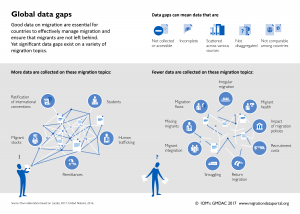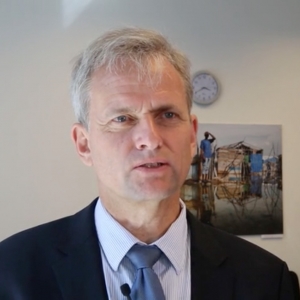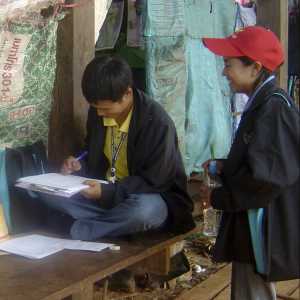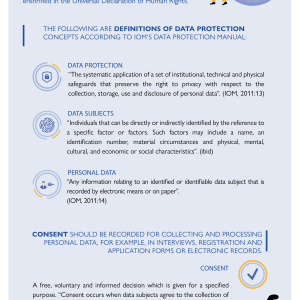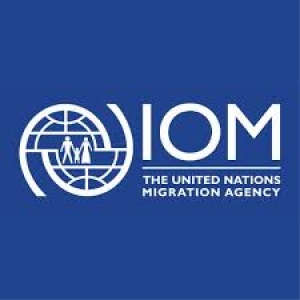If there was one ‘leitmotiv’ during the thematic, regional and civil society consultations for the Global Compact for Safe, Orderly and Regular Migration last year, it was the need to strengthen migration evidence base. Time and again, participants wondered: how can we develop well-managed migration policies, ensure that migrants are not left behind and counter xenophobia and intolerance without reliable information? Not surprisingly, improving migration data ranked high among the 22 objectives of the zero-draft of the Global Compact.
Today, most countries are unable to track the inflows and outflows of migrants and lack a solid baseline to measure progress in achieving migration-related Sustainable Development Goals (SDGs). Significant and dedicated funding is required to bring the quality and availability of migration statistics in line with other development indicators. A global programme for strengthening the collection and use of migration data, as proposed in the draft Global Compact, should include at least five key actions. In addition to strengthening the implementation of existing programmes and guidelines, bold new initiatives are needed if the international community is to make the desired quantum-leap in migration data in the next five to ten years.
1. Capitalize on the 2020 round of population censuses
The population census is the most valuable tool to establish a baseline for the size, composition and well-being of the global population. Most countries already include key migration questions in their censuses, such as country of birth, citizenship and date of arrival. Too often, however, the census fails to cover many migrants, while data are insufficiently disaggregated and slowly disseminated. The global programme should provide dedicated financial support to countries to ensure that (a) core migration questions are included in the census, (b) enumerators are properly trained in identifying migrants, (c) information campaigns encourage migrants to participate, (d) disaggregated migration data are collected, analyzed, verified and disseminated, and (e) migration data are exchanged between countries. This could be achieved by defraying the costs for additional census questions, seconding migration and IT experts to national census teams, carrying out trainings of enumerators and including clear guidance in all census materials. These activities should be guided by the 2017 Principles and Recommendations for Population and Housing Censuses and supported through national coordination mechanisms for census support.
2. Collect existing migration data from administrative sources
All countries maintain registers to administer the adjudication of migration-related processes for foreign citizens such as entry, exit, stay, employment, asylum and citizenship, while labour exporting countries collect similar information on citizens working abroad. While these registers provide an invaluable source of information on migration inflows and outflows, the reasons for migration as well as key characteristics of migrants, including sex, age, country of previous/next residence, length of stay, previous legal status and family characteristics, are generally not published because they are not considered “official statistics”. In addition to developing guidelines for the collection, compilation and dissemination of migration-related data from administrative sources, building on the 1998 Recommendations on Statistics for International Migration, the global programme should boost the collection of such data, informed by good practices such as data collection on asylum applications and decisions (UNHCR), on inflows and outflows of international migrants (UN DESA), on international migration in the Americas (OAS and OECD) as well as country profiles which include administrative data (IOM, ICMPD, etc.).
3. Conduct nationally representative migration surveys
Given the infrequency of the population census and the lack of access to data from administrative records, countries should consider carrying out a nationally representative migration survey every 10 years, five years after the decennial census. Developing survey programmes to address key policy concerns is nothing new. In the early 1970s, the world fertility survey programme responded to concerns about high population growth. Subsequently, the demographic and health survey was launched to address pressing health needs. As part of the global programme, a global migration survey programme would assist national statistical offices by developing standardized questionnaires and manuals, supporting software development, seconding migration expertise, etc. The survey programme, to be carried out by a consortium of research institutes, would build on good practices, such as the Households International Migration Surveys in Mediterranean countries, the Mexican Migration Project and the Programme sur les migrations entre Afrique et l’Europe. Adding migration questions to existing household surveys, such as Labour Force Surveys, Living Standards Measurement Surveys, Demographic and Health Surveys and Multiple Indicator Cluster Surveys, may be a cost-effective alternative, but creates methodological challenges. As a minimum, household surveys should distinguish between migrants and non-migrants.
4. Develop migration training programmes
Recent training programmes and workshops, such those held by UN DESA, in collaboration with the Regional Economic Commissions, ILO, IOM and UNHCR in Addis Ababa, Dakar, Rome and Bangkok have revealed the need for enhanced technical training on (a) estimating migration and (b) measuring the implementation of migration-related goals and targets of the 2030 Agenda. The global programme should sponsor the development of comprehensive and systematic learning programmes on migration for experts working in national statistical offices, ministries of interior and labour, overseas employment agencies, non-governmental organizations and other relevant entities. These learning programmes, a combination of accredited courses at universities and training programmes run by international organizations, should be guided by the 2030 Agenda for Sustainable Development, the New York Declaration for Refugees and Migrants and the future Global Compact for Safe, Orderly and Regular Migration. They should provide training on UN standards for the collection and tabulation of migration statistics, on demographic methods for measuring and estimating migration stocks and flows, on measuring migration-related SDG targets and indicators, on disaggregating the SDGs by migratory status, as well as on data exchange, collaboration and partnerships. These learning programmes should take into account new tools, such as the Handbook for Improving the Production and Use of Migration Data for Development, produced by the Global Migration Group (GMG) with support of KNOMAD, and the Handbook on Measuring International Migration through Population Censuses, published by UN DESA. Training programmes must be complemented with in-country support and follow-up, to be provided by qualified national and, where necessary, international experts.
5. Establish regional migration training centers
Regional training centers are critical to ensure that training and research services are delivered as close as possible to the point of delivery. The call for regional migration observatories in the draft Global Compact is consistent with recent proposals and initiatives, including the African Institute for Remittances, created by the African Union, and the Continuous Reporting System on International Migration in the Americas, developed by the Organization of American States. Under the global programme, regional migration centers could be established in Africa (one francophone, one anglophone), in Asia (1) and in Latin America and the Caribbean (1). Based on the decades-long experience in supporting regional institutes for demographic training and research at the graduate level, such as IFORD and RIPS, these centers should be embedded within existing universities.
The way forward: Cooperation, partnerships and implementation
The global programme should facilitate bilateral, regional and south-south cooperation on migration between statistical offices and research institutions. To balance the need for strengthening existing work flows with developing of out-of-the box solutions, the global programme could be supported by a multi-donor trust fund and executed by a small consortium of international organizations with relevant mandates and expertise. Partners should include the private sector (“big data”), the research community and civil society. Development and use of local expertise must be prioritized.


